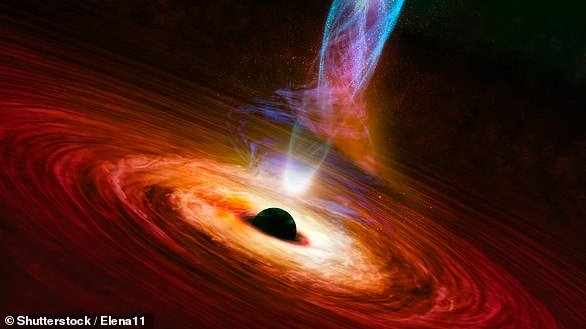What would happen if you fell into a black hole? NASA simulation imagines what it would be like to dive past the point of no return – with terrifying results
It is thought that being sucked into a black hole would be one of the most painful deaths in the universe.
Like any other falling object, you would be forcibly stretched out like a noodle in a process astrophysicists call spaghettification.
Now, an incredible new animation from NASA shows what we would see in our final moments if we were ever able to reach such a void.
The clip, produced on a NASA supercomputer, shows a first-person dive towards the ‘event horizon’ of a supermassive black hole – the dreaded point of no return.
Although it doesn’t show a specific black hole, it is roughly equivalent in size to the monster at the center of our Milky Way Galaxy.
Have you ever wondered what happens if you fall into a black hole? Thanks to a new animation from NASA, viewers can now dive into the event horizon, the point of no return of a black hole

As the video begins and the ‘camera’ approaches the void, we can see the bright orange ‘accretion disk’ with a galaxy in the background
NASA scientists created the animation on the Discover supercomputer at the NASA Center for Climate Simulation in Greenbelt, Maryland.
The project generated approximately 10 terabytes of data – equivalent to approximately half of the estimated text content in the Library of Congress, Washington, DC
“This new immersive visualization, produced on a NASA supercomputer, represents a scenario in which a camera narrowly misses the event horizon and shoots back out,” the space agency says.
“The destination is a supermassive black hole with 4.3 million times the mass of our Sun, which corresponds to the monster at the center of our Milky Way Galaxy.”
As the video begins and the ‘camera’ approaches the void, we can see the bright orange ‘accretion disk’: a hot disk of gas orbiting the black hole and its main light source.
The accretion disk is created by material that emits energy when it falls into the black hole, whether it is gas, dust or matter.
We can also see the thinner photon sphere – a thin ring of light that forms closer to the black hole’s ‘event horizon’.
The term “event horizon,” which spawned the 1997 science fiction disaster film of the same name, is the point at which nothing, not even light, can escape.

Inside the black hole: the bright orange ‘accretion disk’ (top) and the photon sphere (bottom) – the thin ring of light that appears at the edge of the event horizon’s shadow

An annotated black hole: Right in the middle is the event horizon – the point from which nothing, not even light, can escape
The event horizon of the simulated black hole spans about 25 million kilometers, or about 17 percent of the distance from Earth to our sun.
After the video was posted to YouTube, netizens described the clip as “impressive, “beautiful” and “so cool.”
Someone commented: ‘Black holes are such a fascinating part of space, and I think they’re crazy cool, but man, they strike a deep fear in me.’
Another said: ‘Why does this feel scary, like my instincts are kicking in to avoid this.’
Another said it was ‘like I almost fell into a cosmic drain’, while someone else joked: ‘All engines in reverse!’
According to NASA, the first-person perspective of the hypothetical ‘camera’ is greatly accelerated: it manages to reach 60 percent of the speed of light.
The camera would have to show an astronaut’s point of view if we could ever reach a black hole, which is currently impossible.

In the photo the black hole at the heart of the galaxy Messier 87 (M87). The stunning image was released earlier this year
Xavier Calmet, professor of physics at the University of Sussex, said that a black hole’s gravity would become so strong that we would experience ‘spaghettification’.
‘Your body will be stretched into a shape similar to that of a long pasta, until it is pulled apart by the strong force of gravity,’ Professor Calmet told MailOnline.
‘I can’t imagine this would be pleasant; it would happen quite quickly, so if it is painful it is unlikely to last long.’
Dr. David L. Clements, a senior lecturer in the physics department at Imperial College London, said “the end would probably be quick” if it fell into a black hole.
“It could be due to suffocation as the atmosphere is stripped, or the process called spaghettification, where tidal forces stretch everything into long strings – perhaps briefly painful,” he said.
Fortunately, the chances of Earth ever being swallowed by a black hole are “almost zero,” said Dr. Clements.
“The fact that we are still here shows that this has not happened in the entire history of the Earth,” he told MailOnline.
“So the chances are at least once every 4.5 billion years and probably much smaller.”
The closest black hole to Earth, called Gaia BH1, is about 1,600 light-years away and is ten times the size of our Sun.
Researchers recently revealed the second-closest known black hole to Earth, which is about 1,500 light-years away.

